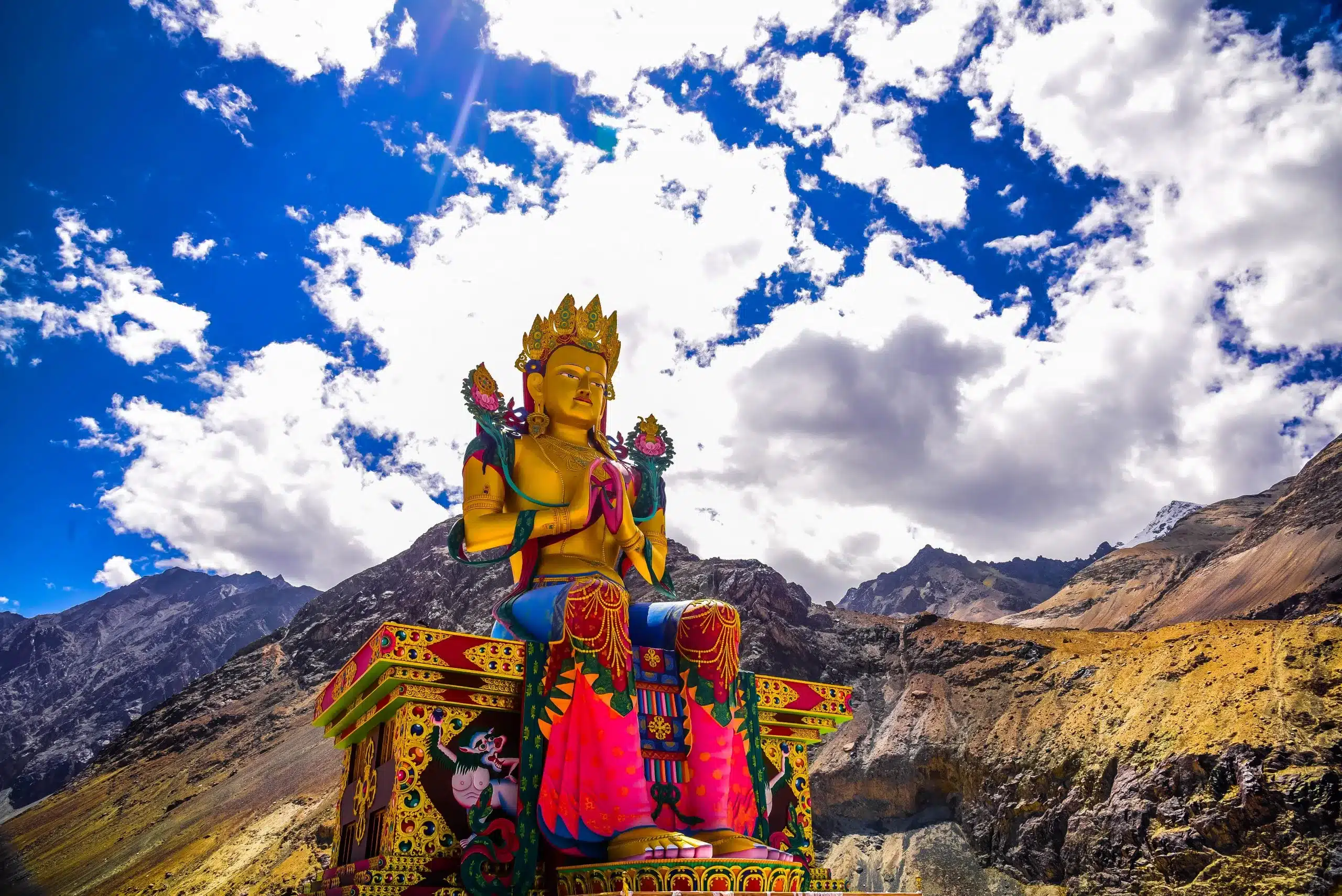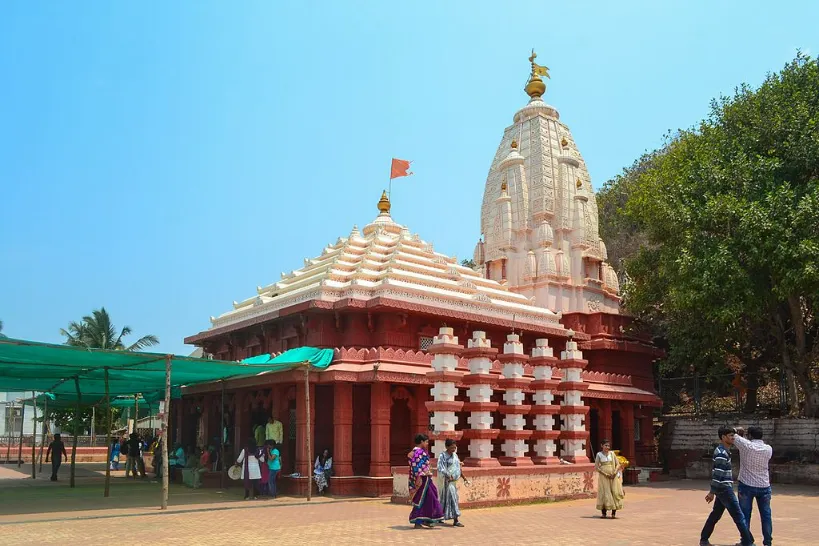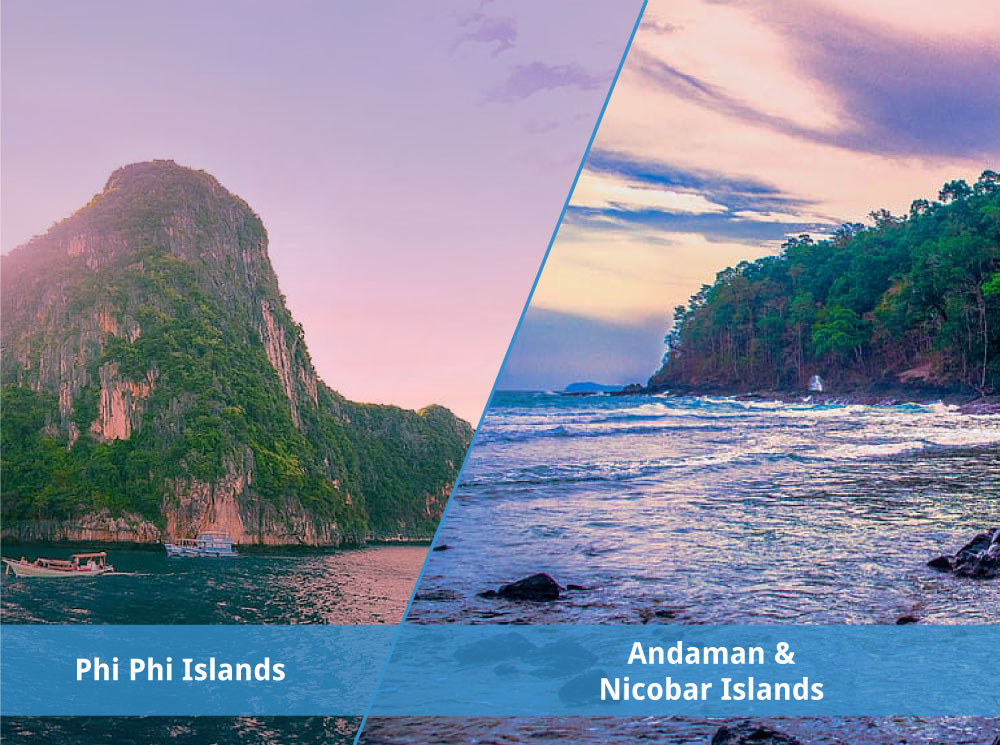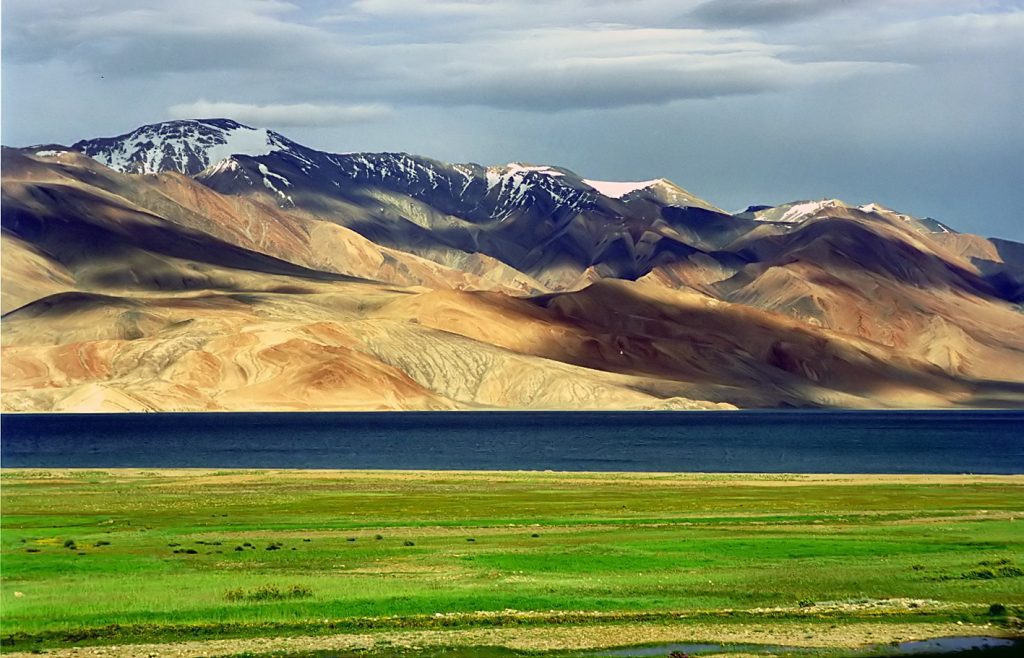It’s sweltering hot, and you’re hanging out with friends, someone casually drops a “Chal, Ladakh chalte hai,” and suddenly, everyone’s excited about the idea. Before you know it, you’re scrolling through breathtaking photos online, adding winter clothes to your shopping cart, and jotting down every scenic spot you must visit. The enthusiasm is palpable, but with the sheer volume of stunning locations, the task of planning starts to feel daunting. It’s easy to become overwhelmed and decide to postpone the trip, waiting for a so-called “better time” for the Leh Ladakh trip that might never come. Planning a Leh Ladakh trip is indeed challenging. Whether it’s a trip from Leh to Nubra Valley or a trip from Leh to Pangong Lake, every corner of the region offers something beautiful.
This makes it tough to cover everything in a limited number of days. Trying to cram too many places into your itinerary can detract from the experience, preventing you from truly enjoying the serene beauty and unique culture of each spot. That’s precisely why we’ve crafted a comprehensive itinerary tailored for you. It focuses on giving you a well-paced journey over 10 days, ensuring you have enough time to appreciate each location without feeling rushed. Simply book your Savaari from Chandigarh, and prepare for what promises to be the road trip of a lifetime. Let’s make that casual suggestion a stunning reality!
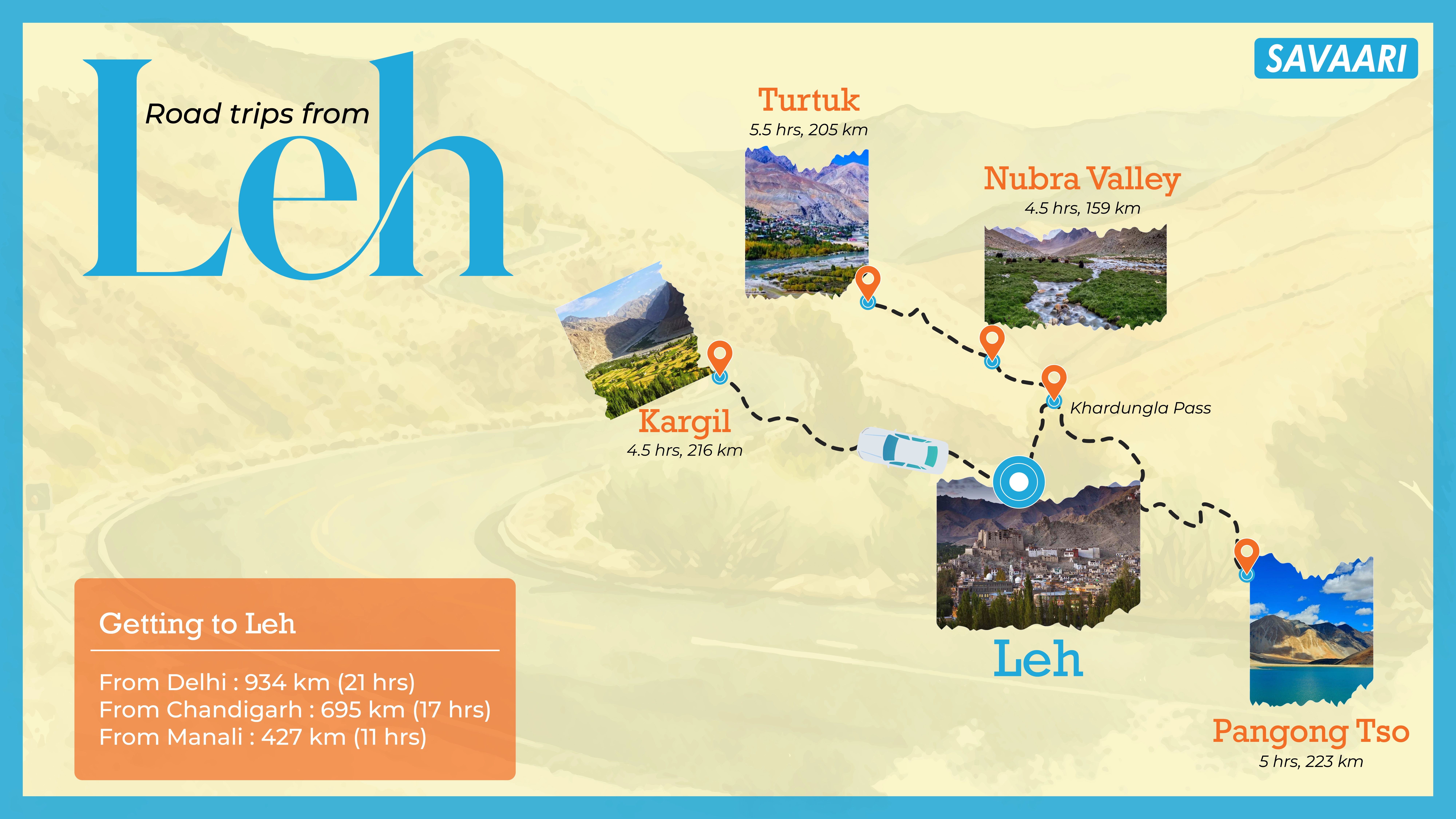
Day 1 – Chandigarh to Manali – Starting the Adventure
Distance and time taken: 5 hr 29 min (269 km)
Your epic road trip kicks off as you journey from Chandigarh to Manali. While you might be keen to get to Leh Ladakh, keep in mind that the Chandigarh to Ladakh distance is 702 km, necessitating two stops in Manali. The route to Manali is not just a necessary leg of the journey but a delightful adventure in its own right. You can find more details about this Chandigarh to Manali road trip route in this blog. The drive is filled with spectacular landscapes and offers plenty of gorgeous spots for you to explore and delicious food to enjoy. Spend your night in Manali, surrounded by beautiful vistas that will leave you invigorated for the days ahead.
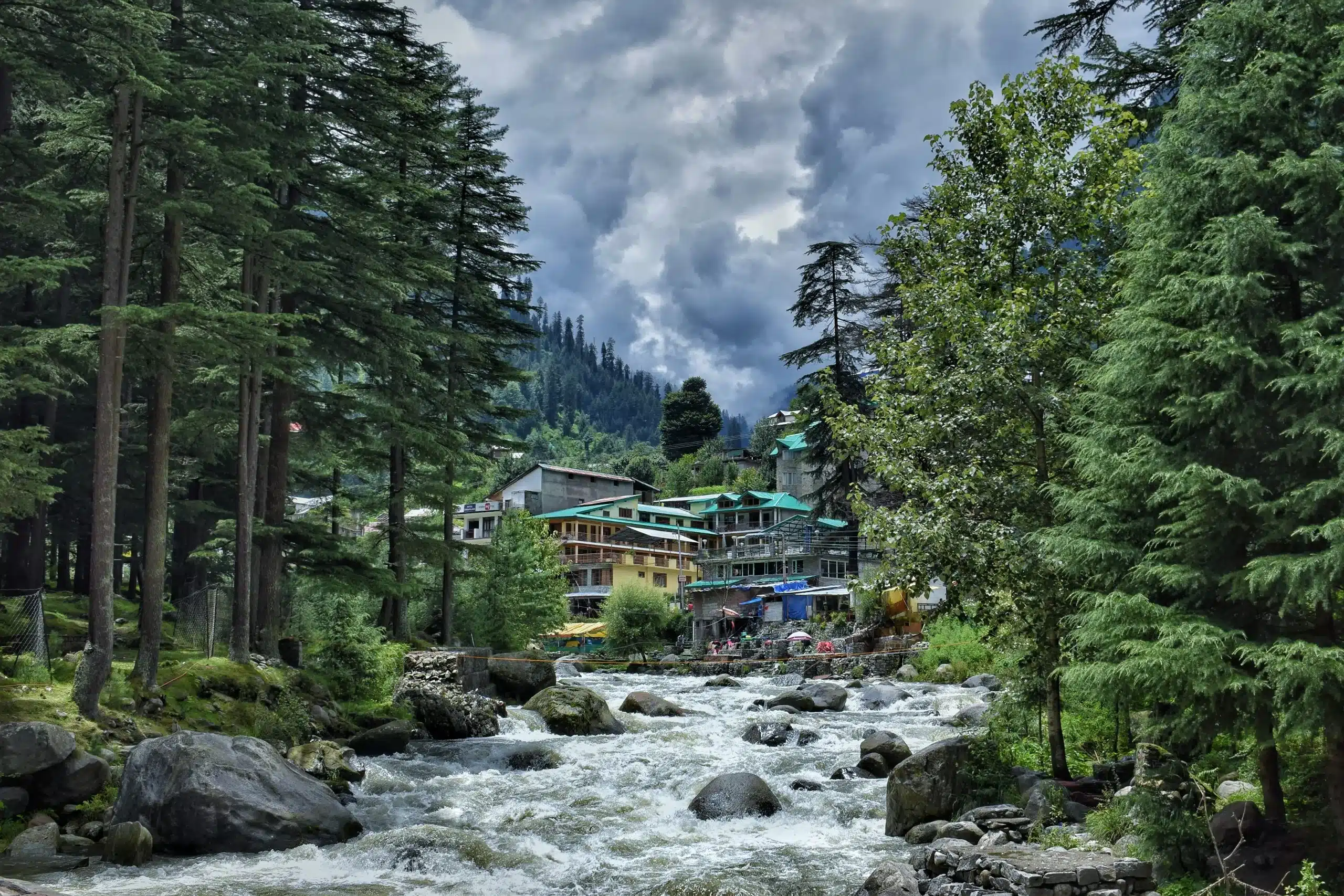
Scenic spots along the way:
- Ropar Wetlands, Ropar: Just outside the city of Chandigarh, these wetlands are a haven for biodiversity. In winter, they serve as a nesting ground for migratory birds, and post-monsoon, they are a good spot to see tortoises.
- Gobind Sagar Lake, Bilaspur: Take a slight detour off the Bilaspur junction to Zakatkhana where the lake merges into the Sutlej River. It’s a tranquil spot perfect for some quiet reflection or a quick stretch.
- Prashar Lake, Mandi: Situated at 9,000 feet, this crystal-clear lake is accessible with a short detour from the highway at Mandi. It offers panoramic views of the Dhauladhar, Pir Panjal, and Kinnaur mountain ranges. It’s also a starting point for treks into the higher Himalayas.
- Great Himalayan National Park, Tirthan Valley: Known for its rich biodiversity, this national park is a must-visit for nature lovers. You can access it by taking a road towards Shoja from Mandi. Consider a stopover here to camp overnight and truly immerse yourself in nature.
- Chandrakhani Pass, Kullu: This mountain pass has lush alpine forests and is crossed by refreshing streams. Make sure to also visit Naggar Castle nearby, an important historic site of Himachal Pradesh.
Local eateries to try
- Bahadur/Bhadure Ka Dhaba, Bilaspur: This well-loved local dhaba is the perfect place to sample traditional meals and quick snacks. It’s a favorite stop for many travelers and locals alike.
- Chawla’s, Mandi: Established and revered, Chawla’s offers a taste of authentic Punjabi cuisine right on the highway, making it a convenient and satisfying meal stop.
Day 2 – Manali to Sarchu
Distance and time taken: 5 hr 1 min (177 km)
Begin your journey from Manali to Sarchu, a drive that takes about 12 hours through some challenging but breathtakingly beautiful landscapes. Given the rough roads and tricky water crossings, especially at Pagal Nala, it’s advisable not to travel during the restricted hours of 6-7 PM. Staying overnight in Sarchu after enjoying the beauty of Manali allows you to explore the area more leisurely.
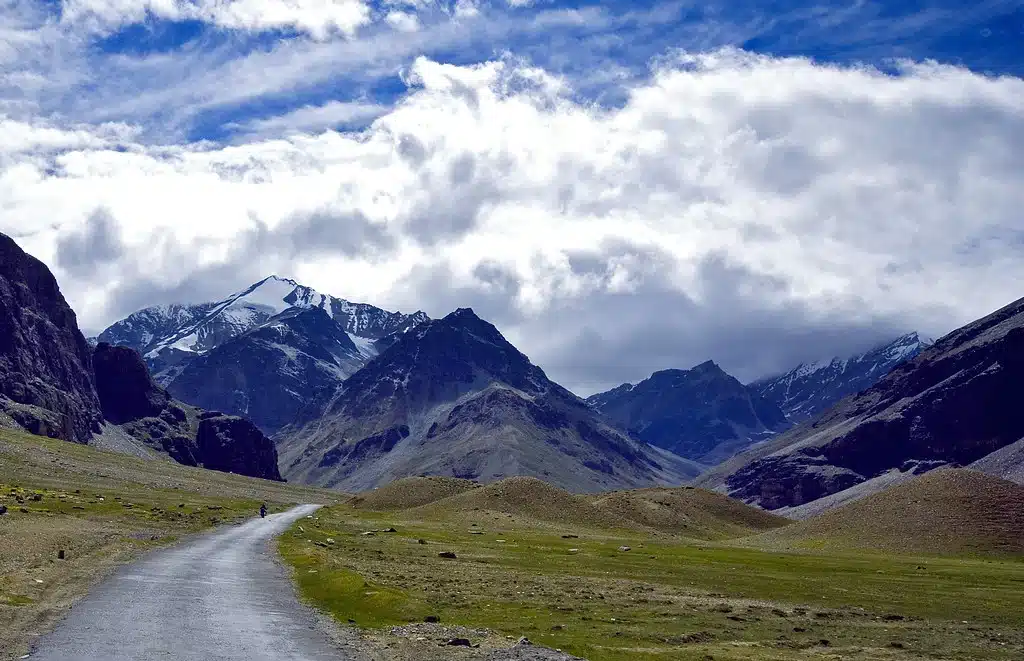
The route features the magnificent Rohtang Pass, which serves as the gateway to the Lahaul and Spiti Valley in Himachal Pradesh. Situated approximately 51 km from Manali at an altitude of 3980 meters on the Manali-Keylong highway, Rohtang Pass offers spectacular views. It’s also a popular spot for adventure sports enthusiasts, offering activities like skiing, ice-skating, and paragliding.
Taking this journey slowly not only lets you adjust to the altitude gradually but also ensures you have plenty of time to soak in the dramatic scenery along the way. Settle into Sarchu for the night, preparing for another day of adventure ahead.
Key highlights along the route
Rohtang Pass: Open to tourists from April to October, travel through this pass is regulated by the Indian Army after they clear the accumulated snow, ensuring safe passage for travelers.
Atal Tunnel: Alternatively, if you’re not traveling via Rohtang Pass, you can take a route that includes the Atal Tunnel. This architectural feat is the world’s longest tunnel at high altitude and significantly cuts down the travel time between Manali and Leh, offering a faster and smoother journey experience.
Chandratal Lake: You can make a pitstop at this lake that has witnessed UFO invasions. The Chandratal lake is associated with numerous intriguing legends, folklore, and a mystery straight out of the X-Files that pique the interest of adventurers.
Sonapani Glacier and Gaypan Peaks: Just beyond Rohtang, these natural wonders offer panoramic views and a serene environment perfect for a refreshing break.
Beas Kund: This is the source of the River Beas, also a sacred site where it is believed Sage Vyas meditated. It’s easily accessible from Rohtang Pass.
Cultural Sites: Explore Gondhla Fort, Shashur Gompa, Tayul Gompa Monastery, and the Lady of Keylong viewpoint for a glimpse into the region’s rich cultural heritage.
Day 3 – Sarchu to Leh
Distance and time taken: 6 hr 15 min (250 km)
Gear up for an early start from Sarchu as you embark on a long, but incredibly picturesque journey to Leh.
Places to visit in the route:
Gata Loops
Gata Loops is a mesmerizing stretch on the Manali-Leh highway, situated at an altitude of about 17,000 feet. This unique section of the road features 21 hairpin bends that span a total distance of 10.3 km, with each bend measuring between 300-600 meters. A notable landmark along this route is the ghost temple, where travelers often leave offerings of mineral water and cigarettes to pacify the resident spirit and ensure a safe journey.
Morey Plains
Morey Plains are located along the treacherous Manali-Leh highway and stand out due to their striking flat terrain at an average elevation of 4,000 meters. It gained additional fame as a filming location for a part of the Bollywood movie “Jab Tak Hai Jaan.”
Hemis
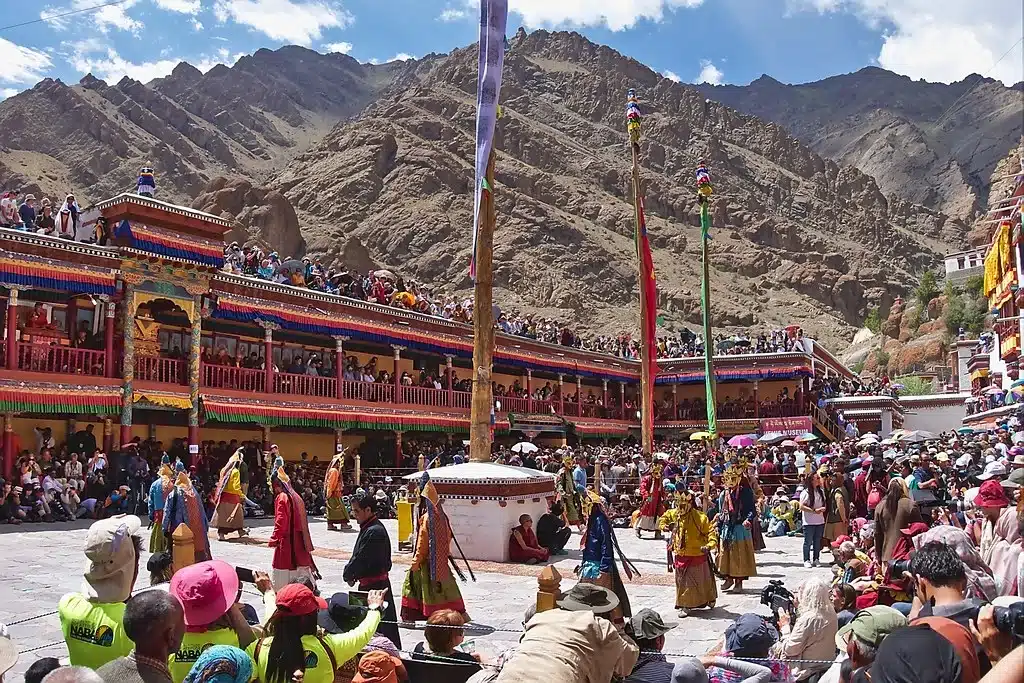
Hemis is renowned for its breathtaking landscapes and rich cultural heritage. It is home to the prestigious Hemis Monastery, which was built under the patronage of Ladakhi King Sengge Namgyal. Hemis is also home to the Hemis National Park. With a variety of langurs, wolves, marmots, deers and red foxes, the national park houses the rare and endangered snow leopard. Check out this comprehensive travel guide on Hemis to make the most of your visit there.
Stakna Gompa
Often referred to as the ‘Tiger’s Nose Monastery’ due to its unique location on a hill shaped like a tiger’s nose, Stakna is a striking example of Buddhist architecture. It offers stunning views of the Indus River below and is a prominent spiritual site in the region.
Shang Gompa
Located in a secluded area, Shang Gompa is ideal for those seeking tranquility away from bustling tourist spots.
Thiksey Monastery
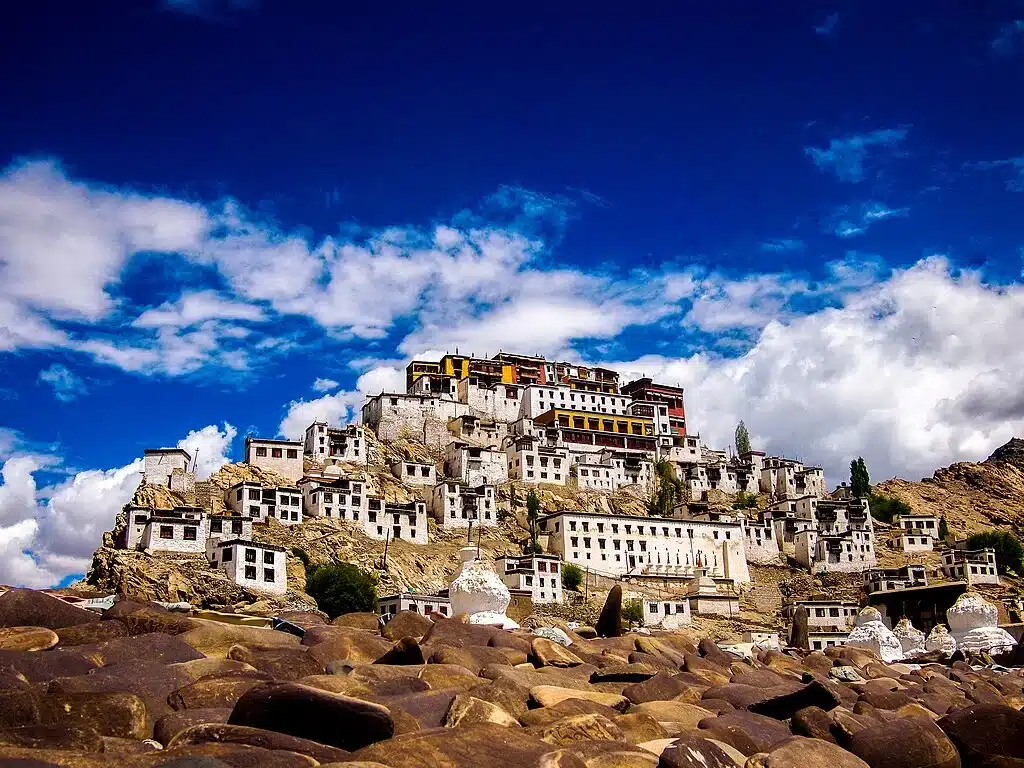
This striking 12-storey structure is situated atop a hill. Thiksey Monastery is arranged hierarchically, with the chief lama’s residence at the top and the monks’ quarters at the base.
Rancho School
Known officially as Druk Padma Karpo School, this educational institution in Leh gained widespread recognition as ‘Rancho’s School’ after its appearance in the Bollywood film ‘3 Idiots’ as the innovative school run by the character played by Aamir Khan. If you are a Bollywood lover, we’ve created road trips featured in your favourite movies here.
Arriving in Leh
Arriving in Leh, it’s a good idea to spend the night at your accommodation, given the rich array of sights and experiences you’ve enjoyed en route. Don’t worry if you feel you haven’t seen enough yet; you’ll be returning to Leh later in your journey. This initial stay is merely the beginning of the many wonders you’ll explore further from Leh. To make the most of your time, immerse yourself in the local culinary scene by trying distinctive dishes such as Tapu, a pancake made from buckwheat flour; Khambir, a traditional brown bread; and Paba, a staple meal of barley flour accompanied by tangy fermented vegetables.
Day 4 – Leh to Kargil via Lamayaru
Distance and time taken: 4 hr 25 min (217 km)
Start your journey early from Leh to Kargil. Take a moment to appreciate the serene landscapes and spiritual energy before you depart.
Journey to Kargil
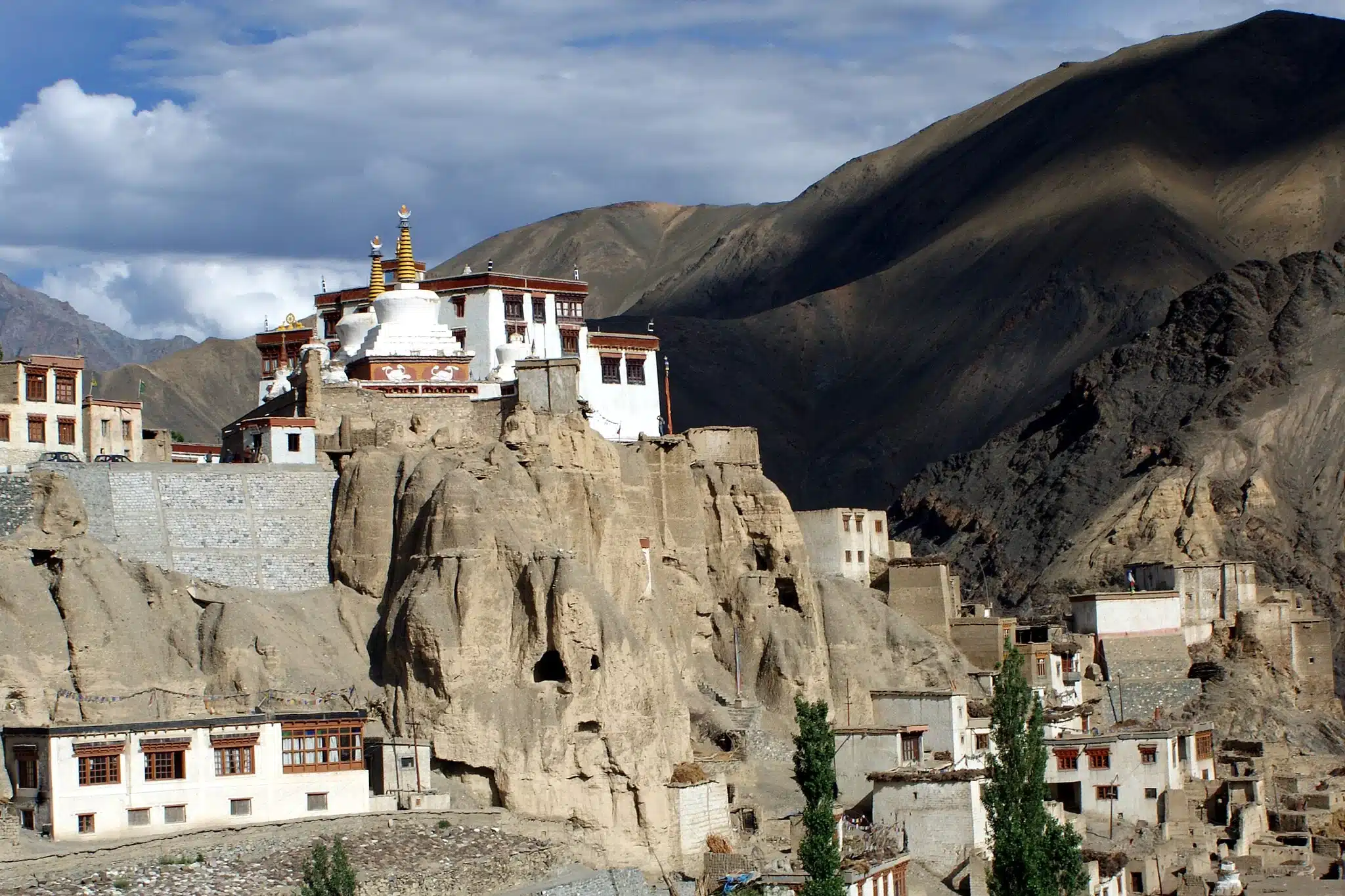
Your drive to Kargil will be filled with several mesmerizing stops that showcase the cultural richness and natural beauty of the region. On your way, make sure to visit Lamayuru, renowned for its ancient monastery set against a dramatic “lunar” landscape. The area, known as the Moonscape for its unique geological formations, offers a surreal experience quite distinct from other parts of Ladakh.
Arriving in Kargil
Kargil, often remembered for its pivotal role in the 1999 Kargil War, stands as a testament to the bravery and sacrifice of Indian soldiers. It is here that intense battles were fought, and victory was claimed, marking a significant chapter in India’s military history. Today, Kargil is not only a place of historical importance but also a hub of serene beauty and adventure. Situated at an elevation of 8,780 feet along the banks of the Suru (Indus) River, Kargil’s landscape is framed by majestic mountains and interspersed with vibrant green valleys. The town serves as a perfect base for adventure activities like trekking, mountaineering, and river rafting, attracting thrill-seekers from around the globe.
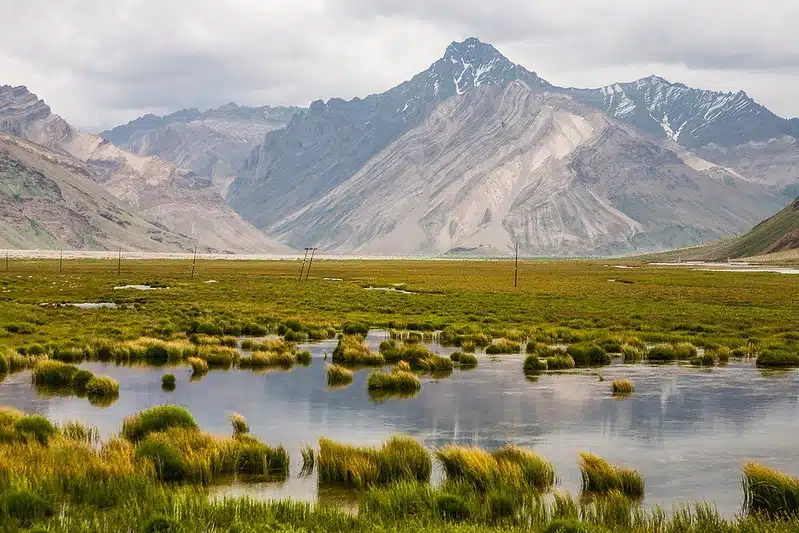
Things to do in Kargil
- Explore the Suru Valley: Stretching from Kargil to the Penzi La watershed, this valley is famous for its breathtaking beauty, with lush orchards and pristine rivers set against the backdrop of towering peaks.
- Visit War Memorials and Museums: The Kargil War Memorial, located near Drass, offers a poignant reminder of the sacrifices made during the conflict. Adjacent to it, a museum recounts stories of heroism and hardship, enriching visitors’ understanding of the war.
- Adventure Activities: The rugged terrain and dynamic waterways of Kargil make it an ideal spot for outdoor sports, offering everything from high-altitude trekking to exhilarating river rafting.
- Cultural Experience in Aryan Valley: Delve into the unique culture of the Dard Aryan community in the Aryan Valley, where traditions have been preserved for over two millennia. The valley has also gained attention for its unique approach to pregnancy tourism, a topic you can learn more about here.
- Marvel at the Colossal Maitreya Buddhas: Significant for both their religious and historical importance, the rock carvings of Maitreya Buddha in the area are profound symbols of the region’s Buddhist heritage.
Finish your day by settling into one of Kargil’s lovely accommodations. Surrounded by a landscape rich in heroic history and natural beauty, Kargil offers a unique and memorable experience, making it an unforgettable stop on your Ladakh journey.
Day 5 – Kargil to Leh
Distance and time taken: 4 hr 26 min (216.4 km)
Journey to Leh
Start your morning by setting off for Leh, a journey that will take a little over 4 hours. This leg of your trip is a stop for you to refuel before your trip from Leh to Nubra Valley. This route is dotted with numerous scenic spots that offer great photography opportunities, making it a delight for nature and culture enthusiasts alike.
- Budhkharbu and Fotu La Top: Capture stunning images of the landscape from Fotu La, the highest point on the road from Kargil to Leh.
- Lamayuru: If you didn’t stop here on your way to Kargil, now is your chance to visit this fascinating place with its ‘moonscape’ terrain and ancient monastery.
- Gurudwara Pathar Sahib: A revered site maintained by the Indian Army, this Gurudwara commemorates the visit of Guru Nanak to the region.
- Indus View near Alchi Road: Take in the spectacular views of the Indus River winding through the valley.
- Basgo Gompa and Spituk Monastery: Explore these ancient monastic sites known for their rich history and vibrant cultural heritage.
- Hall of Fame Leh Museum: A museum run by the Indian Army that showcases the bravery of the soldiers and the history of the Indo-Pak wars.
Arrival in Leh
Arriving in Leh, you’ll be greeted by a blend of breathtaking landscapes and vibrant cultural scenes. Situated at about 11,500 feet above sea level, Leh is a captivating town surrounded by the stunning beauty of the Himalayas. The town serves as a hub for several remote regions of Ladakh and is a melting pot of cultures and traditions. Check out this comprehensive Leh travel guide to make the most of your trip.
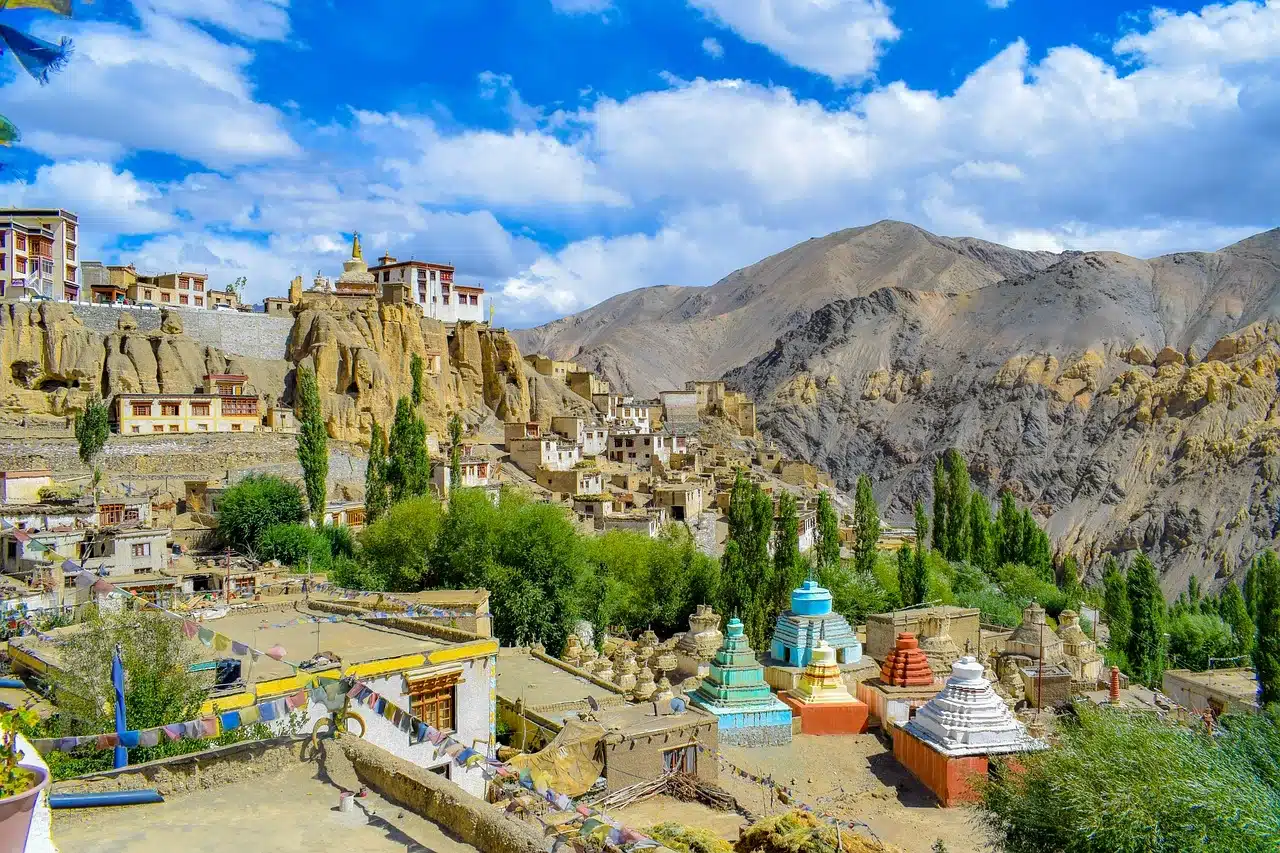
Exploring Leh
- Shanti Stupa: Built on a hilltop in the Changspa region, the Shanti Stupa offers panoramic views of Leh town set against the dramatic backdrop of the surrounding mountains. The stupa is accessible by road, or for the more adventurous, via a staircase that promises invigorating exercise after a few days of acclimatization.
- Leh Main Bazaar: Dive into the bustling main market of Leh where you can taste local cuisines, shop for unique handicrafts, and mingle with both locals and tourists.
- Sankar Gompa: A short walk from Leh, this monastery lights up beautifully in the evening, offering a serene experience during its limited visiting hours.
- Zorawar Fort: Explore the fort that once belonged to General Zorawar Singh, a figure often called the ‘Conqueror of Ladakh’, which provides insights into the region’s historical military significance.
- Datun Sahib: Visit the sacred Meswak tree planted by Guru Nanak, which holds immense religious significance and is located near the Leh Palace.
- Sindhu Ghat: Enjoy a relaxing afternoon by the serene banks of the Indus River, a perfect place for peace and reflection.
- Phyang Monastery: Located about 16 km west of Leh, this monastery houses a fascinating museum with artifacts that trace the cultural history of the region, from Tibetan and Mongolian weapons to Kashmiri bronzes dating back centuries.
- Leh Palace: Overlooking the town, the historic Leh Palace offers a glimpse into the royal heritage of Ladakh, with panoramic views of the surrounding Himalayan landscape.
Finish your day by settling into one of Leh’s many gorgeous accommodation options. Whether you prefer a cosy guesthouse, a luxurious hotel, or a homely homestay, Leh offers a variety of places to rest and rejuvenate before your trip from Leh to Nubra Valley against the backdrop of the majestic Himalayas.
Day 6 – Leh to Nubra Valley via Khardung La pass
Distance and time taken from Leh to Nubra Valley: 5 hr 9 min (188 km)
Journey to Nubra Valley
Your journey from Leh to Nubra Valley takes you across some of the most stunning and challenging terrains. The drive includes a visit to the impressive Diskit Monastery and a thrilling ride over the Khardung La Pass, one of the highest motorable roads in the world.
- Khardung La Pass: At an altitude of 18,380 feet, the Khardung La Pass is not just a gateway to from Leh to Nubra Valley but also an adventurer’s delight. The road to the pass is notorious for its steep gradients and hairpin bends, providing an exhilarating driving experience.
- Diskit Monastery: Located 15 kilometers off the Khalsar-Panakil route, Diskit Monastery stands at an altitude of 10,308 feet, perched atop a hill at the edge of the desert in Nubra Valley. The monastery is famed for its 106 feet tall statue of Maitreya Buddha, which symbolizes protection, peace, and the prevention of further conflicts.
Arrival at Nubra Valley
Nubra Valley, a breathtaking high-altitude desert, is nourished by the waters of the Nubra and Shyok Rivers. This Leh to Nubra valley road trip creates a stark contrast from between the arid desert and the patches of lush greenery. The valley is peppered with quaint villages like Hunder, Diskit, and Sumur, which offer a peek into the local lifestyle and customs.
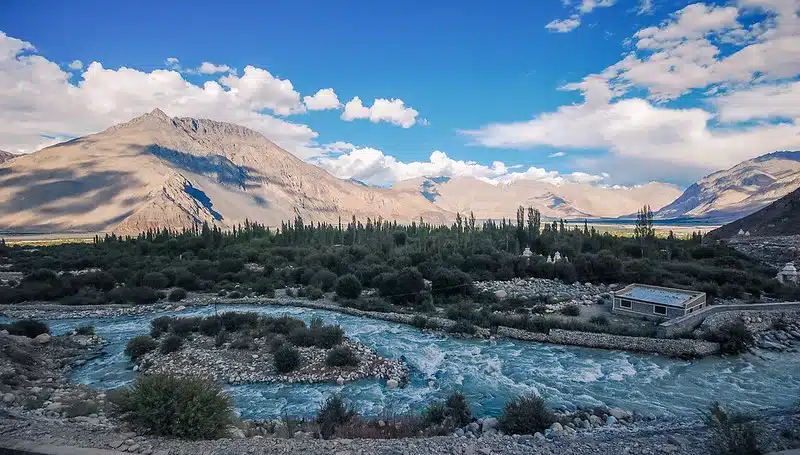
Exploring Nubra Valley
- Bactrian Camel Safari in Hunder: Explore the sand dunes of Hunder on a Bactrian camel, distinguished by its two humps. These camels, historically used as the primary mode of transport along the Silk Route, now provide a unique way for visitors to see the desert.
- Yarab Tso Lake: Often referred to as the hidden lake, Yarab Tso is located near Sumur. Accessible only by an uphill hike, this secluded lake features pristine, crystal-clear waters and is a perfect spot for a tranquil retreat.
- Samstanling Monastery: This 140-year-old monastery in Sumlur village is an essential Buddhist site. The area around the monastery is picturesque, adorned with vibrant prayer flags, berry bushes, and surrounded by golden-grey mountains.
- Panamik Village: Known for its hot springs and beautiful monasteries, Panamik sits at an altitude of about 10,400 feet. The village offers stunning views of the surrounding landscape and is a great place to relax and unwind.
Spend your night in one of the charming accommodations in Nubra Valley, where you can enjoy the stark beauty of the desert landscape while reflecting on a day filled with awe-inspiring sights and unique experiences. This leg of your journey is sure to be one of the most memorable as you connect with the natural and cultural essence of Ladakh.
Day 7 – Nubra Valley to Turtuk
Distance and time taken: 4 hr 10 min (165.6 km)
The journey
Embark on a scenic drive from Nubra Valley to Turtuk, starting your day early to make the most of the beautiful landscapes along the way. This route will take you through some captivating sites:
- Udmaru Bridge and Wooden Suspension Bridge: These structures offer a picturesque view of the surrounding areas and are great spots for photography.
- Shyok War Memorial: Take a moment to pay respects and learn about the local history commemorated by this memorial.
- Chalunka and Chutang: Stop at these settlements to observe the local life and perhaps interact with the welcoming residents.
- Balti Cafe and Restaurant: Enjoy a meal break here, where you can savor the taste of crispy aloo parantha and dal, a comforting and hearty meal to fuel your journey.
Arrival in Turtuk
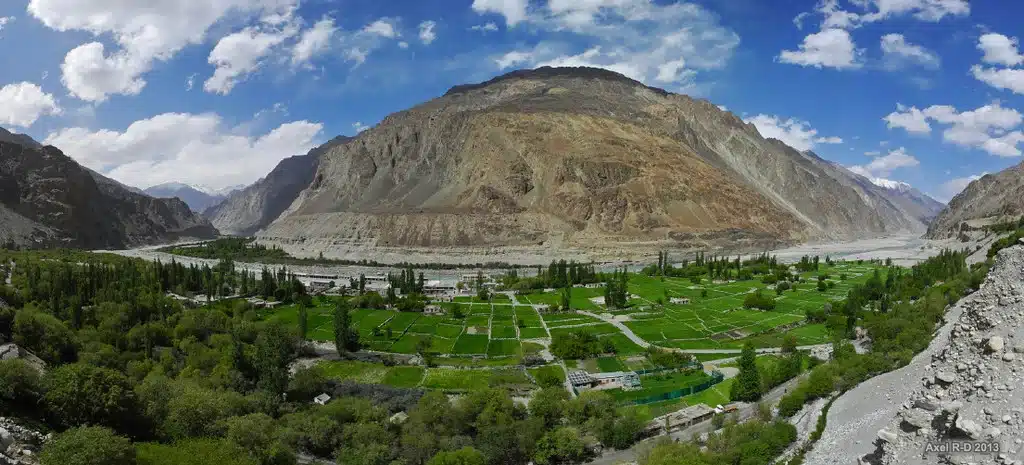
Turtuk, often described as a wonderland, is a unique village situated at the northernmost edge of India before Pakistan-Occupied Kashmir. Lying along the shores of the Shyok River, Turtuk is surrounded by Nubra Valley to one side and Baltistan to the other. This village of approximately 4,000 inhabitants boasts a history as rich and vibrant as the apricot orchards dotting the landscape. Turtuk was once a crucial gateway on the Silk Route and only opened to tourists in 2010 following a local petition.
Exploring Turtuk
Turtuk is not just geographically unique; its cultural tapestry is equally fascinating. The village showcases a blend of Ladakhi, Urdu, and Balti cultures, with Balti being a mix of Persian and old Tibetan. In the Balti Language, the name Turtuk means “desire to stay” and it describes the village perfectly. It is a charming little hamlet that is bound to leave an effect on you. Here’s what you can explore in Turtuk:
- Yul: The oldest area in Turtuk, known for its dense population and lush greenery. Home to one of the village’s two mosques, Yul is a vibrant center of tradition and hospitality.
- Pharol: Accessible by crossing a picturesque bridge, Pharol offers expansive views of buckwheat fields and the distant K-2 peak. It’s also where most of the guesthouses are located, making it a convenient place to stay.
- Local Cuisine: Turtuk’s food reflects its Balti heritage with dishes like dumplings, Thukpa (noodle soup), Sku (stewed vegetables with flour-based pasta), and locally made apricot jam. Be sure to try butter tea, a regional favourite.
End your day by staying in one of the local guesthouses in Pharol. The people of Turtuk are known for their warmth and hospitality, offering you a unique opportunity to immerse yourself in their daily life and culture.
Day 8 – Turtuk to Pangong
Distance and time taken: 7 hr 50 min (320 km)
The journey
As you leave Turtuk and head toward Pangong Tso, prepare for another day of breathtaking landscapes and fascinating stops. The route takes you through several key locations:
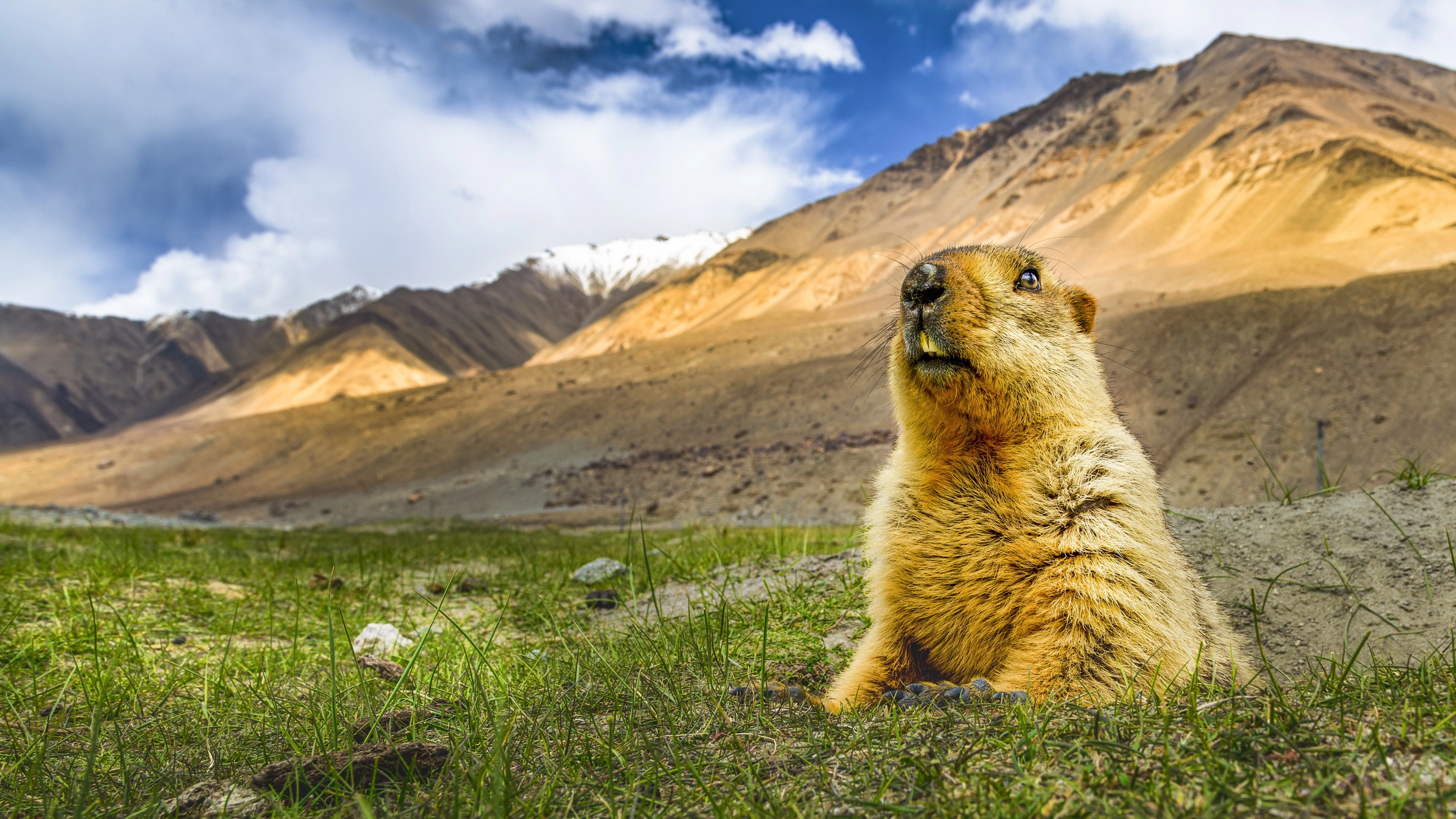
- Hunder and Diskit: If you haven’t explored these places on the previous leg of your journey, make sure to stop by. Hunder is famous for its sand dunes and Bactrian camels, while Diskit is famous for its monastery and the imposing Maitreya Buddha statue.
- Shyok, Durbuk, and Spangmik: These areas offer scenic drives and are crucial waypoints on your route to Pangong Tso.
- Shooting Point: A must-visit for Bollywood enthusiasts, this site on the shores of Pangong Tso has been featured in numerous films, including the famous “3 Idiots”. The picturesque setting with a sand spit enclosing a mini-lagoon draws numerous visitors and is perfect for photography.
- Wildlife Spotting: Keep an eye out for the adorable Himalayan marmots. They call this region their home. These rare creatures are a delight to watch in their natural habitat.
Arrival at Pangong Tso
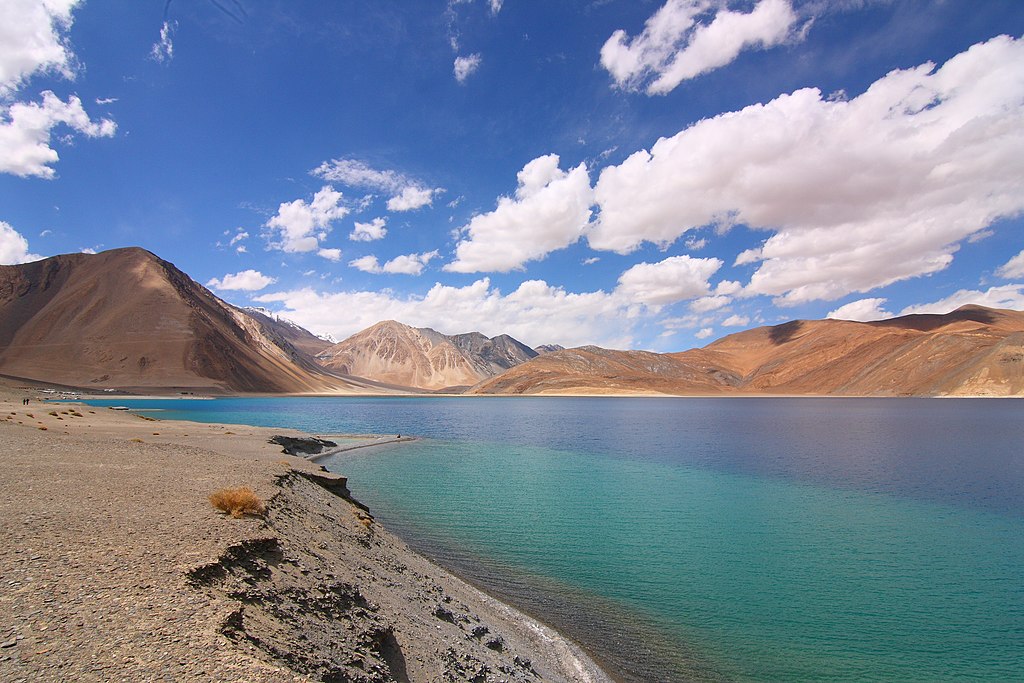
Pangong Tso, meaning “High Grassland Lake,” is one of the highest saltwater lakes in the world, located at an altitude of 14,270 feet. The lake is notable for its vast size and the stunning phenomenon of changing colours – shifting through shades of blue, green, and red depending on the time of day and the weather.
Exploring Pangong Tso
- Natural Beauty and Tranquility: The lake is locked within mountain ranges, with no outlet, contributing to its unique saline nature. During winter, the lake freezes completely, creating a surreal landscape that can be walked upon.
- Visiting Times and Permits: While Pangong Tso is accessible most of the year, the best time to visit is from May to October to avoid the peak tourist season and harsh winter conditions. As of 2022, Indian tourists do not require any permits to travel anywhere in Ladakh.
- Accommodations: The tourism department authorities of Ladakh have requested all travellers to come to Ladakh with a proper booking of accommodations, especially while visiting the Pangong Lake area. Given that Pangong Tso is a sensitive wildlife area and part of a wildlife sanctuary, visitors have to book accommodations in advance. Most accommodations are located about 2 hours away from the lake itself due to the sensitive wildlife sanctuary status of the area. While camping is popular, it’s important to plan responsibly to avoid disturbing the local wildlife. The Pangong Camp Resort run by JKTDC is one option for government-approved accommodations.
Finish your day by settling in at one of the nearby hotels or campsites, offering a peaceful end to a day filled with natural beauty and cultural insights. This ensures you have a restful night before continuing your adventure in Ladakh.
Alternative route from Leh to Pangong Lake
Alternatively, if you are planning on skipping Turtuk, one of the most popular routes is the Leh to Pangong Lake distance. Spanning approximately 223 kilometres, the journey from Leh to Pangong Lake offers breathtaking landscapes and a true adventure through some of the highest motorable roads in the world. For those considering alternatives to the direct route, there are several scenic detours you can take to enhance your experience. The Leh to Pangong Lake distance can be travelled via the Chang La Pass, which provides stunning panoramic views and a thrilling ride. Additionally, exploring nearby attractions such as the Hemis Monastery or the Thiksey Monastery can enrich your trip as you cover the Leh to Pangong Lake distance.
Each route variation still covers the essential Leh to Pangong Lake distance but offers unique sights and experiences, ensuring that the journey is as memorable as the destination. Whether you stick to the main path or explore the diversions, travelling the Leh to Pangong Lake distance is an unforgettable adventure.
Day 9 – Pangong to Leh via Changthang Cold Desert Wildlife Sanctuary
Distance and time taken: 5 hr 35 min (248 km)
Begin your day by leaving the breathtaking views of Pangong Tso behind as you head towards Changthang Cold Desert Wildlife Sanctuary, an area renowned for its unique wildlife and stunning landscapes. This Pangong to Leh road trip will lead you to a vast sanctuary that is home to an incredible array of wildlife, including some of the rarest and most elusive species in the world. Keep your eyes peeled for the majestic snow leopard, the kiang (Tibetan wild ass), and the striking dark-necked crane. The area is also famous for sightings of the Tibetan wolf, wild yak, bharal (Himalayan blue sheep), brown bear, and the ever-present marmot. Bird enthusiasts will delight in the variety of avifauna, with 44 types of waterbirds and numerous migratory species making their appearances depending on the season.
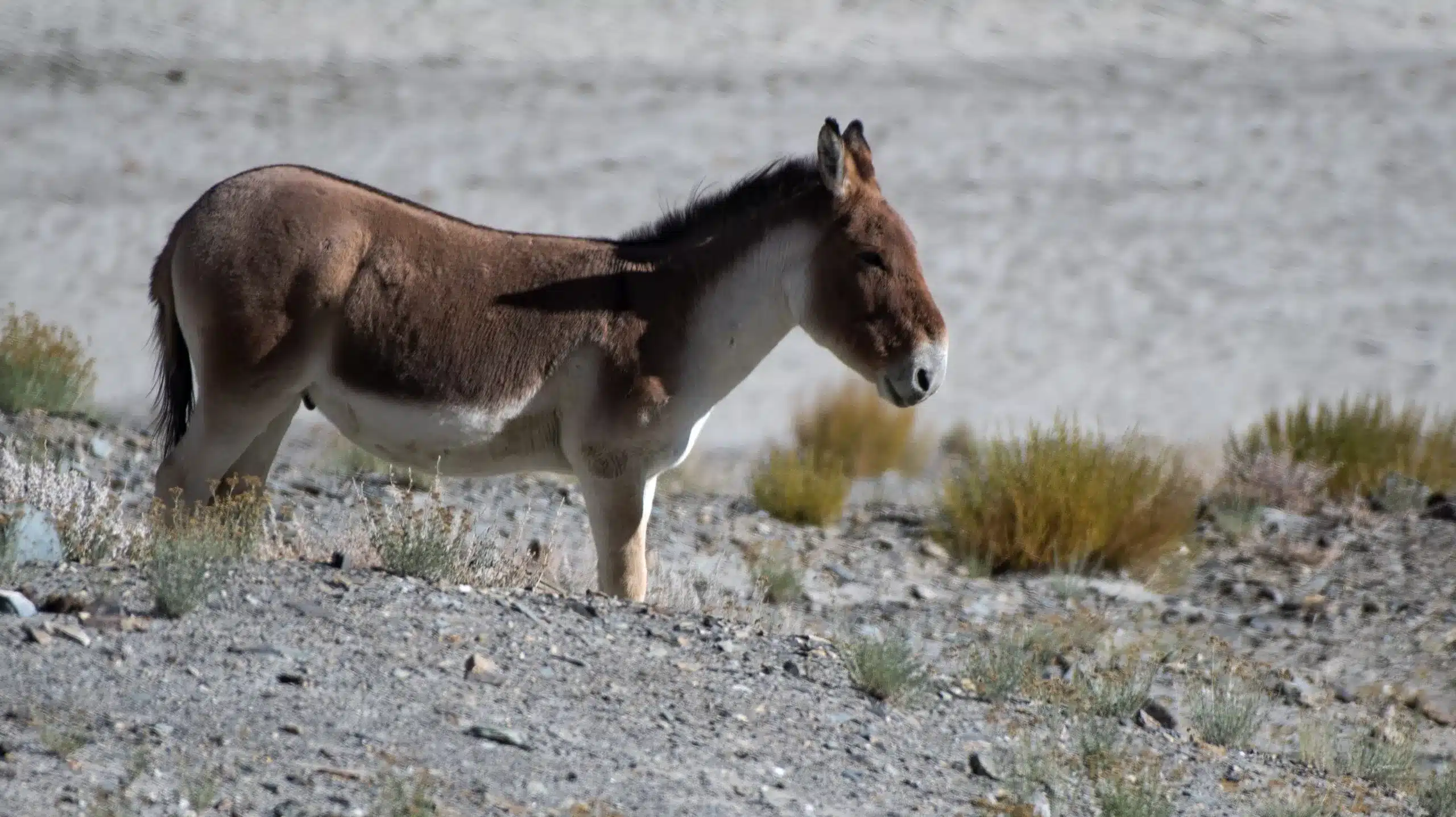
You can also choose to spend some time in Merak, a small village which is over 1 hour away from Changthang Cold Desert Wildlife Sanctuary. This is where you’ll feel as though you’ve stepped into a fairy tale. The village houses nomads who migrated from Tibet, and their unique way of life adds to the charm of this remote settlement.
Day 10 – Back to Leh
After soaking in the tranquillity of the Changthang region, return to Leh, carrying with you the memories of your journey. You can make several stops along the way to savour the final views before heading back to Chandigarh or Delhi by cab.
Exploring Beyond Pangong – Discover Hanle and Tso Moriri
If you’re in Pangong and looking to explore further, consider embarking on two scenic road trips from Pangong to Hanle or Korzok. These routes offer breathtaking landscapes and a deeper dive into the serene and remote beauty of Ladakh.
1. Pangong to Hanle
Distance and time taken: 3 hr 31 min (143 km)
Journey to Hanle
Set off from Pangong for Hanle, passing through the awe-inspiring landscapes of Changthang Cold Desert Wildlife Sanctuary. Your route will guide you through several noteworthy stops:
- Kaktet and Chushul: Traverse these remote areas, where the rugged beauty of Ladakh unfolds around each bend.
- Gandpa Gompa: A lesser-known but enchanting monastery along the way, providing a peaceful respite from the journey.
Arrival at Hanle
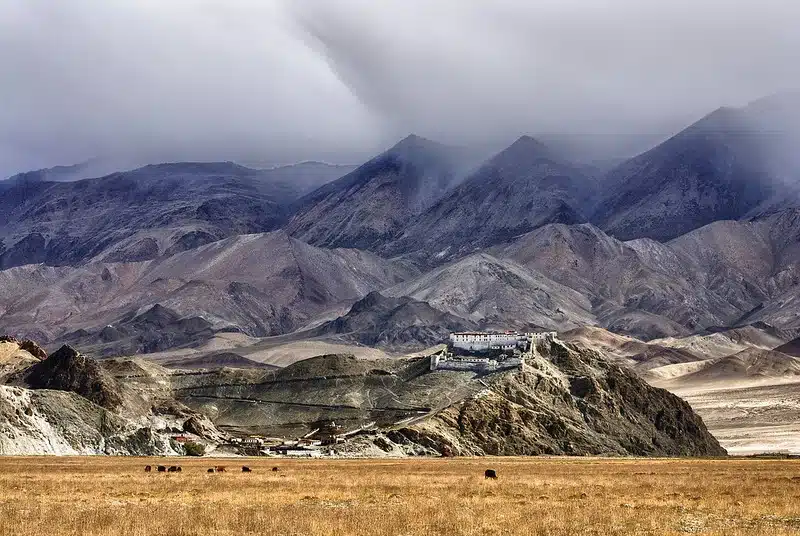
Hanle, in the Changthang region of Ladakh, is a place of sublime beauty and tranquility. Known for its picturesque monastery perched atop a hill, Hanle Ladakh offers spectacular views of the entire village, which is home to about 1,000 people. Hanle in Ladakh is famous for its stunning landscapes and clear skies.
Exploring Hanle
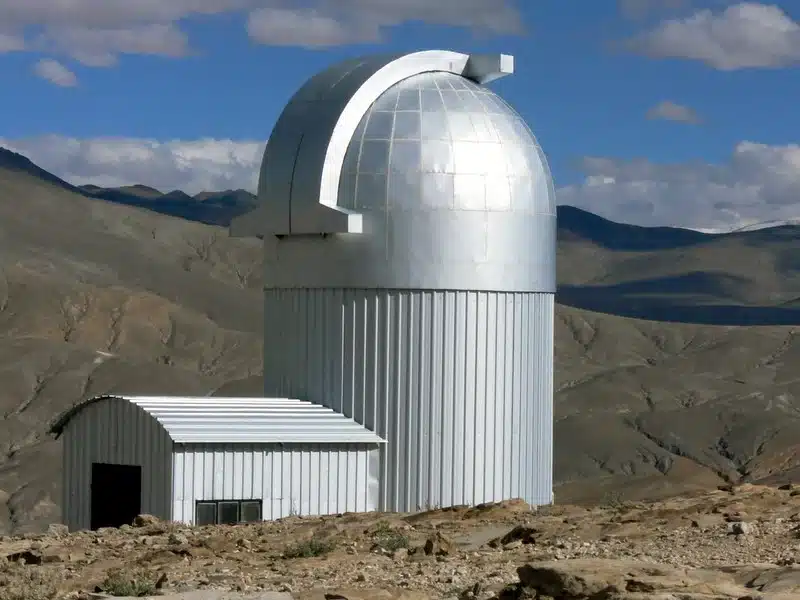
- Astronomical Wonder – Hanle Observatory: Visit one of the world’s highest astronomical observatories. The Hanle observatory’s 2-meter diameter telescope and its location in an area with minimal light pollution make it an exceptional place for stargazing and studying the cosmos. If you’re looking to escape the confines of concrete metropolitan cities and indulge in incredible stargazing experiences, here are the best stargazing destinations in India.
- Bird Watching: Hanle serves as a haven for bird watchers, especially during the winter months when migratory birds such as bar-headed geese visit the high-altitude lakes of Tsomoriri and Tsokar. If you are an avid bird watcher, check out this blog for the best places to go birdwatching in India.
- Hanle Monastery: Immerse yourself in the serene ambiance of this ancient monastery, built under the patronage of King Sengge Namgyal. The monastery is a center of spirituality and Tibetan culture, with about ten lamas residing here.
- Night Sky Viewing: Hanle’s exceptionally clear skies, recognized as India’s first Dark Sky Reserve, offer an unparalleled opportunity to observe celestial phenomena and the Milky Way in stunning clarity. This comes after India recognised Benital as India’s first astrovillage. This makes Hanle not just a cultural and natural retreat but also a prime location for astronomers and stargazers alike.
Important tips for visiting Hanle
- Accommodations: As Hanle is quite remote, it’s wise to plan your stay in advance. There are several beautiful accommodations available, ranging from homestays to guest houses, where you can experience genuine Ladakhi hospitality.
- Dining: Dining options are limited to mostly homestays and guest houses, as there are no commercial food joints. It is advisable to plan your meals with your accommodation and consider packing a lunch if you plan to venture out during the day.
- Cash and Medicines: There are no ATMs in Hanle, so carry sufficient cash for your needs. While basic medicines can be found at army camps, it’s best to bring any necessary medications with you.
2. Pangong to Karzok via Tso Moriri Viewpoint
Distance and time taken: 8 hr 1 min (357 km)

The Journey
The Karzok Way, your route for the day, winds through rugged mountains and alongside sparkling lakes, showcasing the breathtaking beauty of the region.
- Scenic Stops: Along the way, you’ll pass by notable landmarks such as Nyoma Gompa, Sumdo, and Namshang La. Each location offers unique views and cultural insights into the remote areas of Ladakh.
- Tso Moriri Viewpoint: Nestled between mountains, in the Rupshu Valley of lesser Ladakh, the Tso Moriri is the lesser-known cousin of the Pangong Lake. Be sure to stop at this hilltop near Korzok for an awe-inspiring view of Tso Moriri. Known as the Mountain Lake, Tso Moriri’s tranquil beauty is mesmerizing. At 19 km long, this lake contrasts with the more bustling tourist spots like Pangong Tso, offering a serene and introspective atmosphere.
Arrival at Karzok
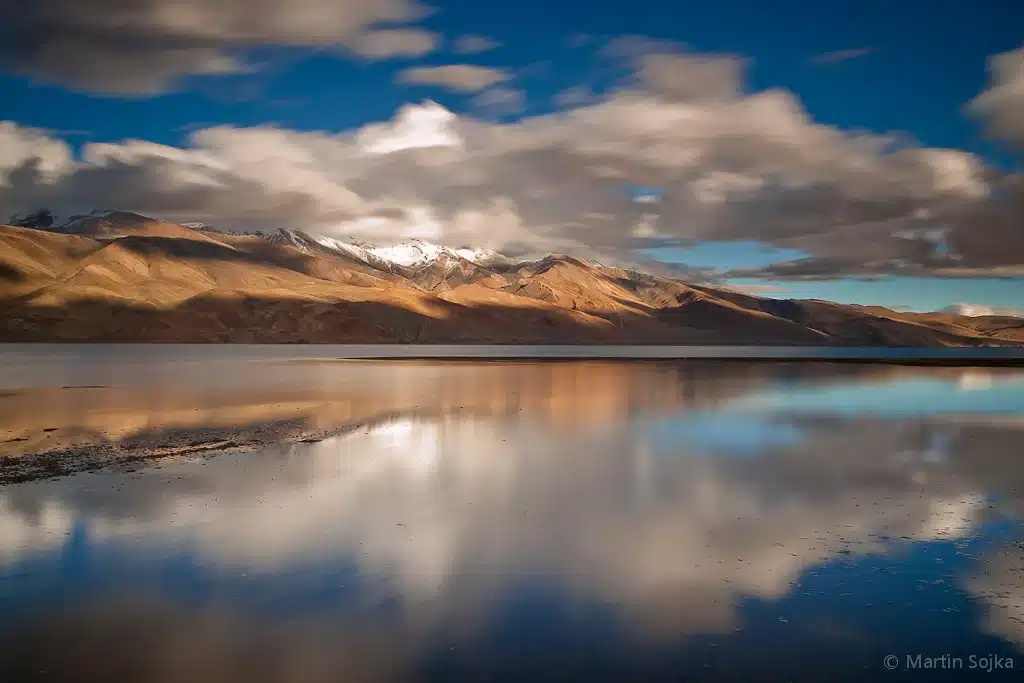
Karzok, located on the banks of Tso Moriri, stands as one of the highest towns in the world and is the highest permanent settlement in India. This high-altitude village is steeped in history and tradition, making it a fascinating place to explore.
Korzok Monastery is home to about 70 monks and is an integral part of the village, which has a population of around 1,300 people. Affiliated with the Drukpa lineage, the monastery features a statue of Shakyamuni Buddha along with other sacred deities. The Korzok Gustor festival held in July/August is a major attraction here, culminating in the symbolic destruction of evil through the dismemberment of the ‘Storma’ (a sacrificial cake) during the Argham ritual.
Staying in Karzok
Choosing to stay in Karzok allows for full immersion into the natural and cultural essence of the Ladakh region. Accommodation options range from homestays to more established hotels, each offering a unique perspective of life at high altitudes. From here, you have easy access to explore the majestic Tso Moriri Lake, surrounded by stark mountain peaks and a peaceful, expansive skyline.
Essential things to know while planning your Ladakh road trip
Embarking on a road trip through Ladakh entails navigating some of the world’s highest motorable passes and experiencing breathtaking landscapes. Here’s what you need to know to ensure a memorable and smooth journey:
Journey from Leh to Nubra Valley
The route from Leh to Nubra Valley stretches approximately 120 kilometers. It takes you over the Khardung La Pass, one of the highest motorable passes globally. While there is an alternative route from Leh to Nubra valley via Wari La, it is more challenging and time-consuming than the direct Khardung La route.
Duration in Nubra Valley
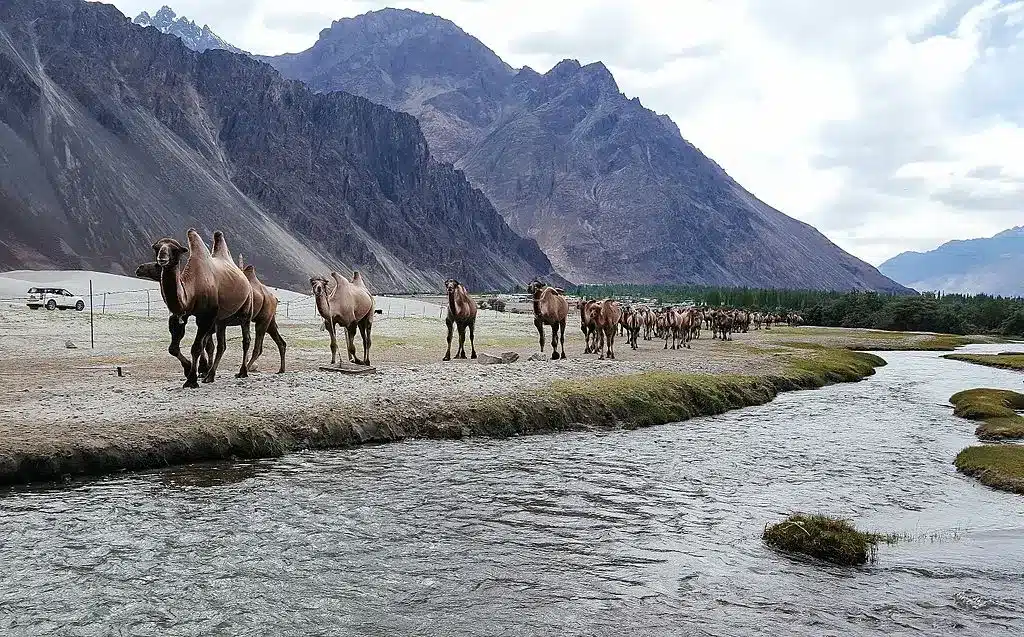
To thoroughly enjoy your road trip from Leh to Nubra Valley, plan for at least three days. This will allow you to explore major attractions like Diskit Monastery, Maitreya Buddha, Hunder sand dunes, Bactrian camels, and the Panamik hot springs comfortably. From Leh to Nubra valley, this is also where the Shyok and Siachen rivers can be seen weaving through the landscape.
Distance between Leh and Nubra via Pangong
Directly from Leh, Nubra is about 150 km via Khardung La, requiring around 5 hours of driving. Including a detour to Pangong, the distance extends to about 500 km.
Temperature comparison
Knowing the temperature is extremely important to know before embarking on a Leh to Nubra Valley road trip. Nubra Valley is generally warmer than Leh as it is at a lower altitude, making the climate slightly milder.
Overnight stays at Pangong Lake
It is not permitted to camp directly on the banks of Pangong Lake due to environmental regulations. Legal accommodations are available about 2 hours away from the lake, where designated camping sites provide facilities while adhering to local laws.
Choosing between Nubra Valley and Pangong Lake
Your choice depends on your interests. Pangong Lake is ideal for those who love scenic natural landscapes and tranquility, whereas Leh to Nubra Valley offers more adventurous activities.
Acclimatization in Leh
Upon arrival in Leh, it is crucial to spend at least 48 hours acclimatizing due to the high altitude. This helps your body adjust to lower oxygen levels, which decreases with altitude due to reduced atmospheric pressure.
Oxygen levels in Ladakh
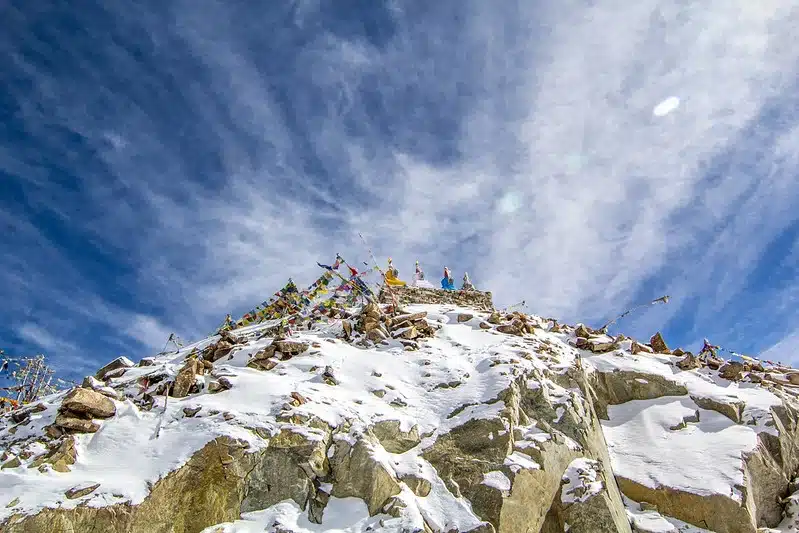
While the oxygen content in the air remains constant, the lower atmospheric pressure at high altitudes like Leh and other popular spots in Ladakh makes it harder for oxygen to enter the bloodstream, which can lead to altitude sickness if not properly acclimatized.
Road conditions to Pangong Lake
The road from Leh to Pangong via Chang La pass is mostly well-maintained, except for some rough patches around the pass. Leh to Pangong Lake distance is 223 km.
Alternatively, the Shyok road from Leh to Nubra Valley to Pangong Lake remains in good condition and offers a smoother ride.
Preferred routes to Leh
The Manali-Leh Highway has seen significant improvements, including bridged water crossings and better road surfaces, particularly from Pang to Taglang La via More Plains. Another comfortable option is the Srinagar-Kargil-Leh route, starting from Srinagar, home to the famous Dal Lake and accessible by air or road from Jammu.
The proximity of Leh to Khardung La Pass
The distance from Leh to the Khardung La Pass, leading further to Nubra Valley, is roughly 120.5 km via the Khardung La Road.
Understanding these details will help you plan a better and safer trip through the stunning regions of Ladakh, ensuring that you can enjoy both the journey and the destinations to their fullest.
Why choose Savaari for your Leh Ladakh road trip?
Embarking on a road trip to Leh Ladakh with Savaari offers numerous advantages, ensuring a seamless and enriching travel experience. Savaari’s chauffeurs are experts in navigating the region’s vast landscapes and challenging terrains. They are well-versed in local routes, helping to avoid any hazardous areas, thus ensuring a safe and comfortable journey.
The convenience of having a cab at your disposal allows you to explore the dramatic changes in scenery from one location to another effortlessly and in comfort. Furthermore, Savaari drivers bring a wealth of local knowledge, from the best eateries and homestays to insightful details about the local culture, enriching your travel experience. All you need to do is download the Savaari app, sit back, and enjoy the beautiful vistas of Leh Ladakh, making way for unforgettable memories.
Last Updated on April 16, 2024 by Shabari Shankar




